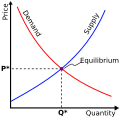
Back مرونة تقاطع الطلب Arabic Кръстосана еластичност Bulgarian Elasticidad cruzada de la demanda Spanish کشش متقابل تقاضا Persian Kereszt-árrugalmasság Hungarian Elasticità incrociata Italian 交差弾力性 Japanese 교차탄력성 Korean Kruislingse elasticiteit Dutch Etterspørselens krysspriselastisitet NB
| Part of the behavioral sciences |
| Economics |
|---|
 |
|
|
In economics, the cross (or cross-price) elasticity of demand (XED) measures the effect of changes in the price of one good on the quantity demanded of another good. This reflects the fact that the quantity demanded of good is dependent on not only its own price (price elasticity of demand) but also the price of other "related" good.
The cross elasticity of demand is calculated as the ratio between the percentage change of the quantity demanded for a good and the percentage change in the price of another good, ceteris paribus:[1]The sign of the cross elasticity indicates the relationship between two goods. A negative cross elasticity denotes two products that are complements, while a positive cross elasticity denotes two products are substitutes. If products A and B are complements, an increase in the price of B leads to a decrease in the quantity demanded for A, as A is used in conjunction with B.[2] Equivalently, if the price of product B decreases, the demand curve for product A shifts to the right reflecting an increase in A's demand, resulting in a negative value for the cross elasticity of demand. If A and B are substitutes, an increase in the price of B will increase the market demand for A, as customers would easily replace B with A,[3] like McDonald's and Domino's Pizza.
- ^ "OECD Glossary of Statistical Terms – Cross price elasticity of demand Definition". stats.oecd.org. Retrieved 2021-04-17.
- ^ Hemmati, M.; Fatemi Ghomi, S.M.T.; Sajadieh, Mohsen S. (2017-09-04). "Inventory of complementary products with stock dependent demand under vendor managed inventory with consignment policy". Scientia Iranica: 0. doi:10.24200/sci.2017.4457. ISSN 2345-3605.
- ^ Das, R. L.; Jana, R. K. (2019-09-01), "Some Studies on EPQ Model of Substitutable Products Under Imprecise Environment", Asset Analytics, Singapore: Springer Singapore, pp. 331–360, doi:10.1007/978-981-13-9698-4_18, ISBN 978-981-13-9697-7, S2CID 202935211, retrieved 2021-04-17
© MMXXIII Rich X Search. We shall prevail. All rights reserved. Rich X Search
